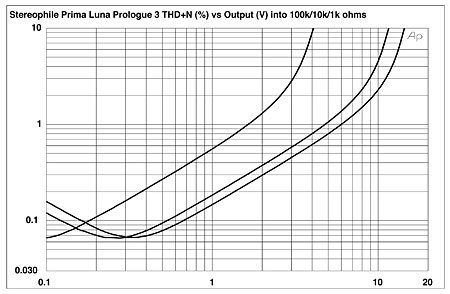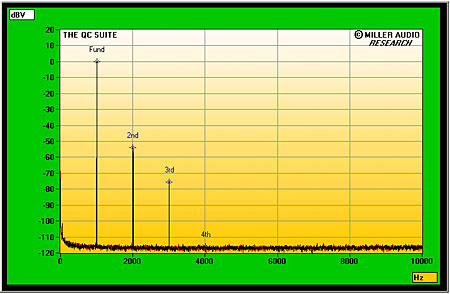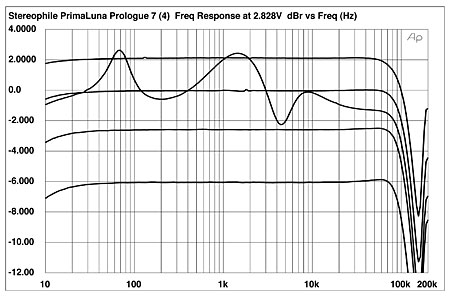| Columns Retired Columns & Blogs |
PrimaLuna ProLogue Three tube preamplifier & Seven monoblock amplifier Measurements
Sidebar 3: Measurements
The Prologue Three's maximum gain was to specification at 12.2dB, and the preamplifier preserved absolute polarity; ie, it was noninverting. The input impedance was usefully high, at around 100k ohms in the bass and midrange. It dropped, slightly but inconsequentially, to 77k ohms at 20kHz. The output impedance was also to specification in the midrange and treble at 2.7k ohms, which is higher than usual, but rose to a high figure of 11.5k ohms at 20Hz. This preamplifier really does need to be used with an amplifier having an input of 50k ohms or more if the bass is not to sound lightweight. At 77k ohms, the Prologue Seven's input impedance will be sufficiently high, I feel. DC offset was negligible, however.
The Prologue Three's frequency response didn't vary at all at high frequencies at different volume-control settings, but did extend a little lower in frequency—0.5dB down at 12Hz set to unity gain (2 o'clock) compared with –0.5dB at 20Hz at maximum volume. But as fig.1 shows, the high-frequency bandwidth increased significantly into low impedances. Note the premature low-frequency rolloff into the unrealistically low 600 ohm load in this graph, but also the excellent channel matching, which was equally good at other volume settings. Channel separation (fig.2) was good in the bass and midrange, at 69dB L–R and 77dB R–L, but worsened above that region due to the usual capacitive coupling.

Fig.1 PrimaLuna Prologue Three, volume control at maximum, frequency response at 1V into (from top to bottom at 100Hz, bottom to top at 100kHz): 100k, 600 ohms (0.5dB/vertical div., right channel dashed).

Fig.2 PrimaLuna Prologue Three, channel separation (10dB/vertical div.).
With the volume control full but the input short-circuited, the Prologue Three's wideband, unweighted signal/noise ratio was a good 68.8dB, improving to 78.4dB when the measurement was restricted to the audioband, and to 94.7dB when A-weighted. Fig.3 plots the THD+noise percentage against output voltage into 100k ohms, 10k ohms, and 1k ohm. Into the higher impedances, the actual distortion starts to rise out of the noise at a few hundred millivolts, and rises linearly with voltage, not actually clipping as such until well above the 1% THD mark, which is our usual definition of clipping. The output voltage into sensible loads at 1% THD was >5V, well above that required to drive the Prologue Seven to its maximum power. Into 1k ohm, however, the output voltage was significantly restricted and the distortion high, again suggesting that the Prologue Three needs to be used with power amplifiers having a high input impedance.

Fig.3 PrimaLuna Prologue Three, THD+N (%)vs 1kHz output voltage into (from bottom to top at 1V): 100k, 10k, 1k ohms.
At 1V output, the THD+N percentage remained around 0.2% into various loads, though the preamp was a little less happy driving low frequencies into low impedances (fig.4), this presumably associated with the LF rolloff. However, even into the 8k ohms input impedance of the Miller Analyzer, the distortion was predominantly second- and third-harmonic in nature (fig.5), which will tend to be subjectively benign. And even into this low impedance, the Prologue Three didn't do too badly on the high-frequency intermodulation test (fig.6), the difference component at 1kHz rising to –60dB (0.1%). This test was taken at 1V output, about the maximum level the preamp liked to put out with this demanding signal.

Fig.4 PrimaLuna Prologue Three, THD+N (%)vs frequency at 1V into (from bottom to top): 100k, 10k, 1k ohms (right channel dashed into 100k ohms only).

Fig.5 PrimaLuna Prologue Three, spectrum of 1kHz sinewave, DC–10kHz, at 1V into 8k ohms (linear frequency scale).

Fig.6 PrimaLuna Prologue Three, HF intermodulation spectrum, DC–24kHz, 19+20kHz at 1V peak into 8k ohms (linear frequency scale).
The input impedance of the Prologue Seven monoblock amplifier (fitted with KT88 output tubes, as noted above) was 77k ohms in the bass and midrange, this dropping to 53k ohms at 20kHz. The Seven was noninverting from all output transformer taps, and the voltage gain into 8 ohms was 27.2dB from the 8 ohm tap, 26.5dB from the 4 ohm tap, and 25dB from the 2 ohm tap.
The Prologue Seven's output impedance was extremely high from the 8 ohm tap, at 8.5 ohms at treble and midrange frequencies, and rising to 9.1 ohms at 20Hz. It was around 4.5 ohms from the 4 ohm tap, and still 2.6 ohms from the 2 ohm tap. These impedances will maximize power transfer into loads that equal the transformer-tap rating, but will introduce large variations in frequency response with real-word loudspeakers. Into our standard simulated loudspeaker, for example, there were ±2.2dB variations in response from the 4 ohm tap (fig.7), rising to ±3dB variations from the 8 ohm tap (fig.9), and even ±1.6dB changes from the 2 ohm tap (fig.8).

Fig.7 PrimaLuna Prologue Seven, 4 ohm tap, frequency response at 2.83V into (from top to bottom at 2kHz): simulated loudspeaker load, 8, 4, 2 ohms (0.5dB/vertical div.).

Fig.8 PrimaLuna Prologue Seven, 2 ohm tap, frequency response at 2.83V into (from top to bottom at 2kHz): simulated loudspeaker load, 8, 4, 2 ohms (0.5dB/vertical div.).

Fig.9 PrimaLuna Prologue Seven, 8 ohm tap, frequency response at 2.83V into (from top to bottom at 2kHz): simulated loudspeaker load, 8, 4, 2 ohms (0.5dB/vertical div.).
Also apparent in this graph is the amplifier's very wide small-signal bandwidth: low frequencies that are flat to 20Hz and ultrasonic frequencies that are not down 3dB until 110kHz. Though there is the start of some parasitic peaking evident, this doesn't reach its maximum until above the 200kHz limit of my measurement. Other than its high secondary impedance, the Prologue Seven's output transformer is obviously an impressive component. Note the excellent shape of the 1kHz squarewave (fig.10), and that while the ultrasonic resonance results in some overshoot, the 10kHz squarewave (fig.11) reveals that the ringing is relatively mild.

Fig.10 PrimaLuna Prologue Seven, 8 ohm tap, small-signal 1kHz squarewave into 8 ohms.

Fig.11 PrimaLuna Prologue Seven, 8 ohm tap, small-signal 10kHz squarewave into 8 ohms.
The unweighted, wideband S/N ratio (ref. 2.83V into 8 ohms with the input shorted) depended on the transformer tap used, ranging from 85dB (8 ohm tap) through 87.1dB (4 ohm tap) to 88.7dB (2 ohm tap). These are good figures, and the PrimaLuna amplifiers did not seem sensitive to grounding issues (though I must admit I didn't use the preamp and power amps together, as Bob Deutsch did, which was when he got some ground-loop buzz; I should also note that Bob's Avantgarde speakers use powered subwoofers, which introduces another grounding variable into the mix).
With its low negative feedback, it was not surprising to find that the distortion present in the Seven's output rose linearly with output power into all loads, whether the measurement was taken from the 8 ohm tap (fig.12), the 4 ohm tap (fig.13), or the 2 ohm tap (fig.14). But provided the load impedance was equal to or greater than the nominal transformer tap, the distortion can be seen to be respectably low at powers below a few watts. The actual "knees" in these graphs' traces, where true waveform clipping actually begins to occur, are all above our usual 1% THD definition of clipping. But even at 1% THD the Prologue gets close to its specified power, provided the load is twice the tap rating. For example, it delivers 58W into 16 ohms from the 8 ohm tap (20.65dBW), 57.2W into 8 ohms from the 4 ohm tap (17.6dBW), and 50W into 4 ohms from the 2 ohm tap (14dBW). It will deliver the full 70W (18.45dBW) into a matched load only if the clipping criterion is relaxed to 3% THD.

Fig.12 PrimaLuna Prologue Seven, 8 ohm tap, distortion (%)vs 1kHz continuous output power into (from bottom to top at 10W): 16, 8, 4, 2 ohms.

Fig.13 PrimaLuna Prologue Seven, 4 ohm tap, distortion (%)vs 1kHz continuous output power into (from bottom to top at 10W): 16, 8, 4, 2 ohms.

Fig.14 PrimaLuna Prologue Seven, 2 ohm tap, distortion (%)vs 1kHz continuous output power into (from bottom to top at 10W): 16, 8, 4, 2 ohms.
The low distortion into higher impedances was maintained across quite a wide bandwidth, though some rise in THD can be seen in the very low bass and at ultrasonic frequencies. Fig.15 shows the behavior from the 4 ohm tap; the distortion was a little higher at all frequencies into all loads from the 8 ohm tap (fig.16), a little lower from the 2 ohm tap (fig.17).

Fig.15, PrimaLuna Prologue Seven, 4 ohm tap, THD+N (%)vs frequency at 2.83V into (from bottom to top): 16, 8, 4, 2 ohms.

Fig.16, PrimaLuna Prologue Seven, 4 ohm tap, THD+N (%)vs frequency at 2.83V into (from bottom to top): 16, 8, 4, 2 ohms.

Fig.17, PrimaLuna Prologue Seven, 4 ohm tap, THD+N (%)vs frequency at 2.83V into (from bottom to top): 16, 8, 4, 2 ohms.
Like the Prologue Three preamplifier's, the Prologue Seven's distortion at small-signal levels is heavily second-order (fig.18), though some higher-order harmonics can be seen at very low levels (fig.19). All the harmonics rise in level as the output power increases, and with the 4 ohm tap delivering 20W into 8 ohms (fig.20), the second harmonic lies at –48dB (0.4%). In addition, some sidebands at ±120Hz appear around the fundamental tone at this power. Though they lie at –100dB, their appearance suggests that the power supply is starting to work hard. And at highish powers of low frequencies into a matched load, the distortion is definitely starting to reach levels I would have thought audible (fig.21). The amplifier's performance on the high-frequency intermodulation test, at levels below actual waveform clipping (fig.22), was also a little disappointing, the 1% difference component resulting from an equal mix of 19kHz and 20kHz tones reaching –38dB (1.2%).

Fig.18 PrimaLuna Prologue Seven, 8 ohm tap, 1kHz waveform at 1W into 8 ohms (top), 0.22% THD+N; distortion and noise waveform with fundamental notched out (bottom, not to scale).

Fig.19 PrimaLuna Prologue Seven, 4 ohm tap, spectrum of 1kHz sinewave, DC–10kHz, at 1W into 8 ohms (linear frequency scale).

Fig.20 PrimaLuna Prologue Seven, 4 ohm tap, spectrum of 1kHz sinewave, DC–10kHz, at 20W into 8 ohms (linear frequency scale).

Fig.21 PrimaLuna Prologue Seven, 8 ohm tap, spectrum of 50Hz sinewave, DC–1kHz, at 20W into 8 ohms (linear frequency scale).

Fig.22 PrimaLuna Prologue Seven, 4 ohm tap, HF intermodulation spectrum, DC–24kHz, 19+20kHz at 20W peak into 8 ohms (linear frequency scale).
In many ways, the PrimaLuna Prologue Three and Seven are nicely engineered, considering their relatively affordable prices. But the preamplifier's decreasing linearity at low frequencies definitely mean that it should not be used with power amplifiers whose input impedance drops much below 50k ohms. And the power amplifier's high source impedance from all its output-transformer taps means that it will produce audible response changes with pretty much every speaker with which it is used. It does look as if the Prologue Seven's owner would be advised to use the output tap that is half the nominal impedance of his speakers. This will give the optimal tradeoff among nonlinearity, noise floor, and maximum power; ie, the amplifier will work best with 8 ohm speakers using its 4 ohm tap.—John Atkinson
- Log in or register to post comments



































